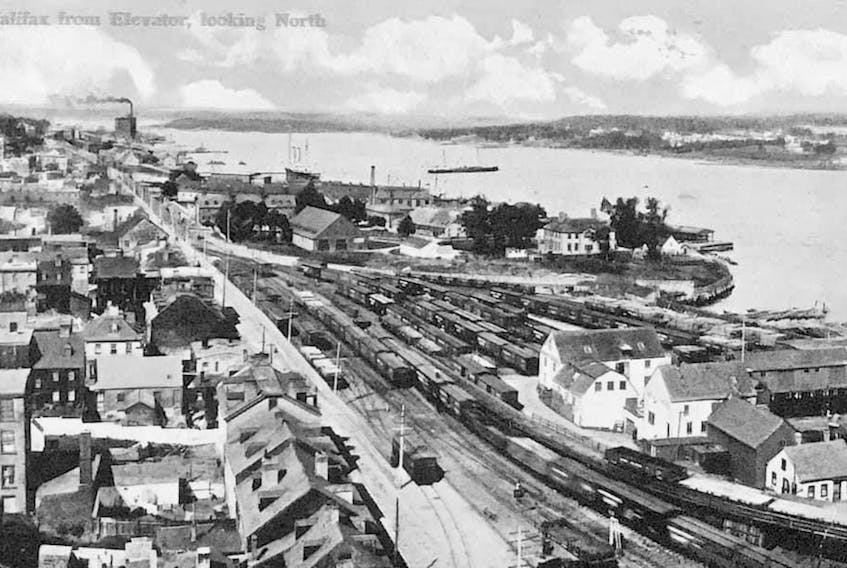4 July 1898 - Shortly before 5 a.m., while travelling at full speed in a dense fog, the French postal steamer SS La Bourgogne collided with the British ship Cromartyshire 60 nautical miles off Sable Island.
Five hundred and fifty lives were lost from the La Bourgogne (out of 726). The Cromartyshire, which had been travelling at only four knots with its fog horn sounding, survived the collision and was able to save 173 survivors. News of the sinking was reported in Halifax on 6 July when the Cromartyshire arrived in Halifax harbour in tow by the S.S. Grecian.

After the survivors arrived onshore, controversy erupted when it was learned that only about 13 percent of the passengers survived, while over 48 percent of the crew did. All the officers had died and it was reported that violence and “desperate fights” had broken out as sleep-weary passengers fled to their lifeboats. Only one woman was rescued out of 300 and no children survived.
5 July 1881 - The Royal Canadian Academy of Arts exhibition was held for the first time in Nova Scotia at Province House, Halifax. A year earlier, on 6 March 1880, His Excellency the Marquis of Lorne, Governor-General of Canada and Her Royal Highness, The Princess Louise, opened the first exhibition in Ottawa in what was then called the Canadian Academy of Arts. It was later designated by Queen Victoria, as the Royal Canadian Academy of Arts on 16 July 1880.
During their residency in Canada, both his Excellency and Her Royal Highness were active promoters of Art and Design culture in Canada. His Excellency was also an accomplished sketch artist, while Princess Louise had received formal art education at the British National Art Training School. During their stay in Canada, both had painted or sketched a number of works reflecting their interest in nature and the Canadian wilderness.
In Nova Scotia, British-born, Halifax resident landscape and marine seascapes artist, Forshaw Day (1831-1903), became a founding member of the newly formed Academy. In 1882, 27-year-old Nova Scotia artist Frances Bannerman also became the first woman elected to the Academy.
Six years later, in 1887, the Victoria School of Art and Design was established with the help of Anna Leonowens. It was the precursor of the Nova Scotia College of Art and Design, now known as NSCAD.
(Reference: Records of the Founding of the Royal Canadian Academy [electronic resource]: by His Excellency The Marquis of Lorne and Her Royal Highness The Princess Louise, 1879-80. Royal Canadian Academy of Arts. Hathi Trust Digital Library.)
6 July 1775 - The New England Chronicle and Essex Gazette published Thomas Jefferson’s Declaration Setting Forth the Causes and Necessity of Taking Up Arms. A year later on 4 July 1776, the Continental Congress declared the British King, George III, a tyrant and pronounced the New England colonies free and independent states. The political philosophies of republicanism and liberalism took hold, rejecting rule by monarchy and inherited aristocracy.
News of the beginning of the American Revolutionary War (1775-1783) would soon reach Halifax. But residents and merchants alike had known for some time that trouble was brewing, starting with the Stamp Act of 1765, then the Boston Massacre in 1770 and three years later, the Boston Tea Party had erupted.
By the time a declaration of peace was announced and Britain recognized American independence in September 1783, thousands of Loyalist refugees would arrive in Nova Scotia, doubling the province’s population.
Military officer and artist, Lieutenant Colonel Edward Hicks, stationed in Halifax from 1778 to 1782 with the 70th Regiment of Foot, graphically documented with many images of the young Halifax settlement during the later years of the War of the American Revolution.

7 July 2010 - The Royal Astronomy Society of Canada declared the Kejimkujik National Park and National Historic Site to be an official Dark Sky Preserve, consisting of 404 sq. km. of mainly second-growth forest. Parks Canada now has 26 designated Dark-Sky Sites in Canada. The locations can be identified at https://rasc.ca/lpa/dark-sky-sites.
On Aug-19-21, the Annual Kejimkujik Dark Sky Weekend will take place.
Source: https://www.rasc.ca/lpa/kejimkujik-national-park.)

8 July 1874 - George Brown (1839-1875) of Herring Cove was named championship oarsman of the world. A champion single and long-distance sculler, Brown had won five years in a row the $150 belt awarded from the Royal Nova Scotia Yacht Squadron. He was also the only Nova Scotian to win the World’s Single Rowing Championship.
(Reference: SportNovaScotia.ca)
9 July 1875 - A tourist/travellers’ handbook on the Maritime Provinces was published this year from Cambridge, Massachusetts, called The Maritime Provinces: A Handbook for Travellers. A Guide to Chief Cities, Coasts, and Islands of the Maritime Provinces by M. F. (Moses Foster) Sweetster, Cambridge, MA: James K. Osgood and Company. The material had been compiled from the “Editor’s personal experience, after many months of almost incessant travelling.”
The publication was to “assist the traveller in gaining the greatest possible amount of pleasure and information while passing through the most interesting portions of Eastern British America…with economy of money, time, and temper, by giving lists of hotels with their prices, descriptions of the various routes by land and water, and maps and plans of the principal cities.”
Halifax was described by the editor as both the capital of the province and the “chief naval station of the British Empire in the Western Hemisphere, (occupying) a commanding position on one of the finest harbours of the Atlantic Coast.”

If one was arriving in Halifax (pop. 29,582) by rail, the guide suggested that after arriving at the Richmond railway station (today that would be located at the bottom of North Street on Barrington - the Intercolonial Railway depot was still under construction near there and would later open in 1877), it was “some distance from the city (downtown), but passengers can go in either by carriage, hotel-omnibus, or horse-car….” Hotels to consider included The Halifax Hotel, “the largest in the province,” at 107 Hollis - $2 a day; the International, also on Hollis St., - $1.75-$2. a day; the Carlton House on Argyle, which was described as “small but aristocratic.”
If one wanted to travel outside Halifax, “stages” left the city daily for Chester, Lunenburg, Liverpool, Shelburne and Yarmouth - departing at 6 a.m. There were also stages leaving for the Eastern Shore on Monday, Wednesday and Friday. There was also rail to Windsor in the Annapolis Valley, to Truro and on to New Brunswick.
As for international travel from Halifax, the Allan Line Steamships and a number of other steamers provided passenger service from the city to Liverpool, Boston, Norfolk, Baltimore, the West Indies and Panama, Bermuda, Glasgow, Newfoundland and Prince Edward Island. And a steamer also leaves “the old college town” at Windsor every Wednesday at “high water,” touching first at Parrsboro and then on to Saint John, New Brunswick.

10 July 1778 - During this time, the name Fort Needham first appeared on the glacial drumlin hilltop in the north end of Halifax. A couple of years earlier the hilltop site had been known as Pedley’s Hill Redoubt, formerly owned by James Pedley who had farmed there for many years. The land had been expropriated in 1776 to construct a fort to protect the north end of the Halifax Naval Dockyard.The American Revolutionary War was underway and fears remained high of a possible attack on Halifax by the American revolutionaries.
Designed by William Spry and constructed during the summer of 1778, Fort Needham was captured in an early illustration by military officer and artist, Lieutenant Colonel Edward Hicks in 1780. By the late 1880s, Fort Needham fell into ruins and the land became a polo ground for officers from the nearby Wellington Barracks and a rifle range. It is now the home and fitting location for the Fort Needham Memorial Park in remembrance of the victims of the Halifax Explosion.
(Reference: “Needham Street,” William D. Naftel. Pp.107-108. In Halifax Street Names An Illustrated Guide. Shelagh MacKenzie, with Scott Robson, eds. Halifax: Formac Publishing, 2002.)
(Leo J. Deveau is an independent librarian, researcher, speaker and author of 400 Years in 365 Days - A Day by Day Calendar of Nova Scotia History. His most recent book is Fideliter The Regimental History of The Princess Louise Fusiliers. He can be reached at [email protected]).









